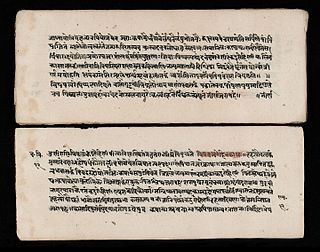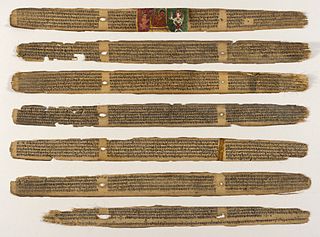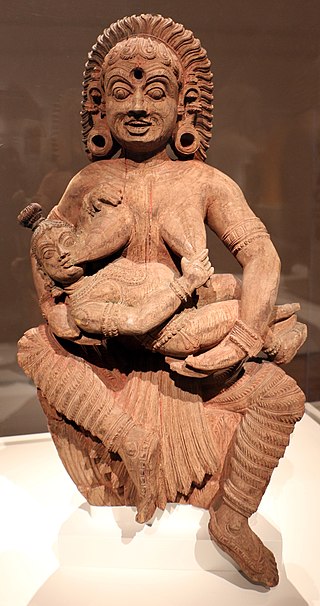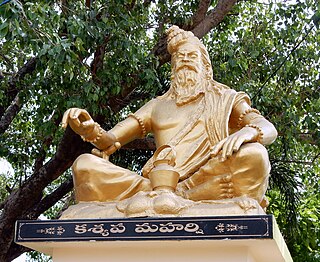Bharadvaja was one of the revered Vedic sages (maharishi) in Ancient India. He was a renowned scholar, economist, grammarian and physician. He is one of the Saptarishis.

Ayurveda is an alternative medicine system with historical roots in the Indian subcontinent. It is heavily practiced in India and Nepal, where around 80% of the population report using ayurveda. The theory and practice of ayurveda is pseudoscientific.

Charaka was one of the principal contributors to Ayurveda, a system of medicine and lifestyle developed in ancient India. He is known as a physician who edited the medical treatise entitled Charaka Samhita, one of the foundational texts of classical Indian medicine and Ayurveda, included under Brhat-Trayi.
Vāgbhaṭa (वाग्भट) is one of the most influential writers, Scientist, Doctor and advisor of ayurveda. Several works are associated with his name as author, principally the Ashtāṅgasaṅgraha (अष्टाङ्गसंग्रह) and the Ashtāngahridayasaṃhitā (अष्टाङ्गहृदयसंहिता). The best current research, however, argues in detail that these two works cannot be the product of a single author. Indeed, the whole question of the relationship of these two works, and their authorship, is very difficult and still far from solution. Both works make frequent reference to the earlier classical works, the Charaka Samhita and the Sushruta Samhita. Vāgbhaṭa is said, in the closing verses of the Ashtānga sangraha to have been the son of Simhagupta and pupil of Avalokita. His works mention worship of Cows and Brahmanas and various Vedic Gods, he also begins with a note on how Ayurveda evolved from Brahma. His work contains syncretic elements.
Saṃhitā literally means "put together, joined, union", a "collection", and "a methodically, rule-based combination of text or verses". Saṃhitā also refers to the most ancient layer of text in the Vedas, consisting of mantras, hymns, prayers, litanies and benedictions.

The Bower Manuscript is a collection of seven fragmentary Buddhist Hybrid Sanskrit treatises found buried in a Buddhist memorial stupa near Kucha, northwestern China. Written in early Gupta script on birch bark, it is variously dated in 5th to early 6th century. The Bower manuscript includes the oldest dated fragments of an Indian medical text, the Navanitaka.
The Atharva Veda or Atharvana Veda is the "knowledge storehouse of atharvāṇas, the procedures for everyday life". The text is the fourth Veda, and is a late addition to the Vedic scriptures of Hinduism.

The Vedas are a large body of religious texts originating in ancient India. Composed in Vedic Sanskrit, the texts constitute the oldest layer of Sanskrit literature and the oldest scriptures of Hinduism.
Agnivesha is a legendary rishi (sage) in Hinduism, reputedly one of the earliest authors on Ayurveda. He is described to have codified the knowledge of his preceptor, Atreya, and arranged it in the form of a treatise, named the Charaka Samhita.

The Charaka Samhita is a Sanskrit text on Ayurveda. Along with the Sushruta Samhita, it is one of the two foundational texts of this field that have survived from ancient India. It is one of the three works that constitute the Brhat Trayi.

The Sushruta Samhita is an ancient Sanskrit text on medicine and surgery, and one of the most important such treatises on this subject to survive from the ancient world. The Compendium of Suśruta is one of the foundational texts of Ayurveda, alongside the Charaka-Saṃhitā, the Bhela-Saṃhitā, and the medical portions of the Bower Manuscript. It is one of the two foundational Hindu texts on the medical profession that have survived from ancient India.
Kashyap Samhitā, also known as Vriddha Jivakiya Tantra is a treatise on Ayurveda attributed to the sage Kashyapa.

Sushruta, or Suśruta is the listed author of the Sushruta Samhita, a treatise considered to be one of the most important surviving ancient treatises on medicine and is considered a foundational text of Ayurveda. The treatise addresses all aspects of general medicine, but the impressive chapters on surgery have led to the false impression that this is its main topic. The translator G. D. Singhal dubbed Suśruta "the father of plastic surgery" on account of these detailed accounts of surgery.
In Ayurvedic medicine, the compilation of traditional ancient Indian medicine practice is called rasaśāstra(रसशासत्र ), which details processes by which various metals, minerals and other substances, including mercury, are purified and combined with herbs in an attempt to treat illnesses. Rasashastra is a pharmaceutical branch of Indian system of medicine which mainly deals with the metals, minerals, animal origin product, toxic herbs and their use in therapeutics.

In Hinduism, Pūtanā is a rakshasi (demoness), who was killed by the infant-god Krishna. Putana disguises as a young, beautiful woman and tries to kill the god by breast-feeding poisoned milk; however Krishna sucks her milk as well as her life via her breasts. Putana is also considered as a foster-mother of Krishna as she breast-fed him. By offering her milk, Putana had performed "the supreme act of maternal devotion", in the shadow of her evil motives. The legend is told and retold in Hindu scriptures and some Indian books, which portray her variously as an evil hag or a demoness who surrendered herself to Krishna, though she initially came with evil motives.
The Agamas are a collection of several Tantric literature and scriptures of Hindu schools. The term literally means tradition or "that which has come down", and the Agama texts describe cosmology, epistemology, philosophical doctrines, precepts on meditation and practices, four kinds of yoga, mantras, temple construction, deity worship and ways to attain sixfold desires. These canonical texts are in Tamil and Sanskrit.

Gynocardia is a genus of dioecious evergreen tree belonging to the Achariaceae family, containing the sole species Gynocardia odorata. The trees grow up to 30 m tall. The species is found in moist forests of mountain valleys in South Asia - India, South-east Tibet and Yunnan in China, Bangladesh, Nepal, Bhutan and Myanmar.

Kashyapa is a revered Vedic sage of Hinduism. He is one of the Saptarishis, the seven ancient sages of the Rigveda. Kashyapa is the most ancient and venerated rishi, along with the other Saptarishis, listed in the colophon verse in the Brihadaranyaka Upanishad.
An Ashtavaidya is a practitioner of the Ayurveda system of medicine belonging to a group of families of Namboothiri in the Indian state of Kerala. Among the Ayurvedic healers of Kerala, the Ashtavaidyas are the physicians who are masters of the eight branches of Ayurveda mentioned in classical texts. It was this expertise in the eight branches that earned them the epithet of ashtavaidya. These branches are dealt with in detail in the treatise Ashtānga Hridayam one of the primary texts of Ayurveda. The eight branches of Ayurveda are Kaya, Bala, Graha, Urdhvanga, Shalya, Damshtra (toxicology, Jara and Vrisha.
In several ancient Indian texts, Nagnajit appears as the name of a king or kings who ruled Gandhara and/or neighbouring areas. Some texts also refer to Nagnajit as an authority on temple architecture or medicine. According to one theory, all these references are to a single person; another theory identifies them as distinct persons.










